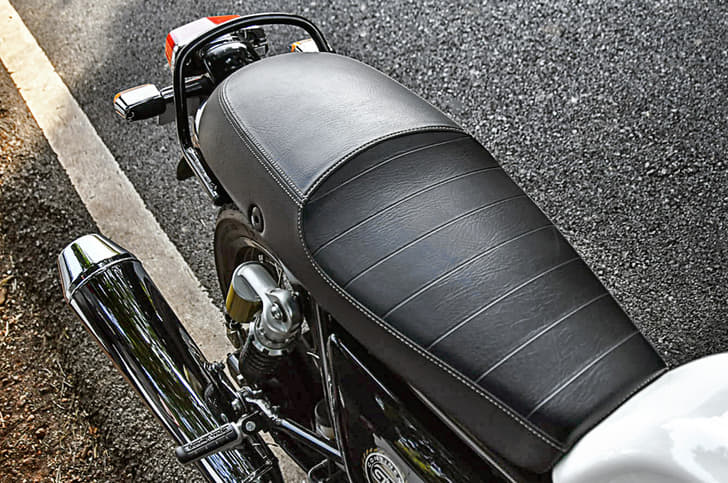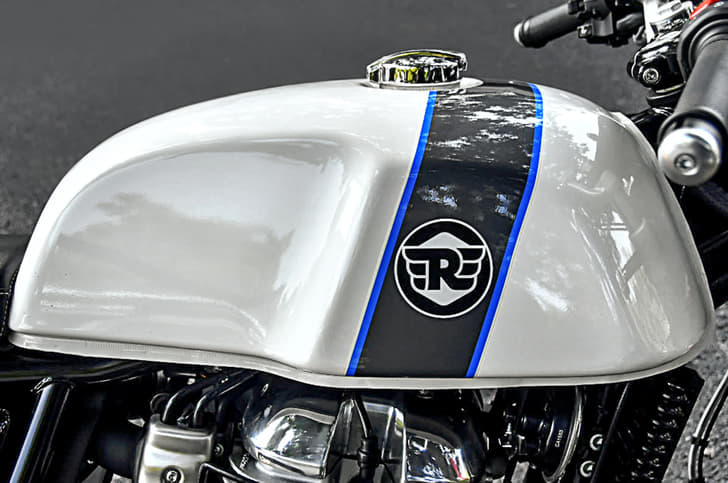The Interceptor is clearly the bigger prospect for Royal Enfield in India, between the new 650 Twins. However, comments online indicate that there’s a very real fan following for the Continental GT 650 as well, especially from those who’ve gazed at images and have quite easily concluded that the Conti is just that little bit extra special to look at. But what about how it rides, especially on our roads? Happily, we’ve also managed to get some seat time with the Continental GT at the first ride in Goa and discovered that it has much to offer that’s similar to the Interceptor, but also some qualities that are quite different.
It was fitting that the first stretch of road we got to experience the Conti on was a fast set of bends on the smooth road to Agonda in South Goa. Here, this bike immediately puts a bigger smile on your face than its sibling. Thanks to the more committed riding position with clip-on bars and slightly further rear-set pegs than the Interceptor, you feel a deeper connect to the Conti. This urges you into riding harder and it is quite a bit on fun on these kinds of roads.
For those of you who aren’t aware, the Interceptor and Continental GT share the same platform underneath, including the chassis, suspension, brakes, tyres and engine tune. The Conti also drops the main stand that’s seen on the Interceptor, but I didn’t miss it very much – getting the Interceptor onto the main stand takes some muscle. Given how closely these two are related, I’m not going to focus too much here on what’s similar, but instead I’ll tell you how the Continental GT feels different from its sibling.
Aiding the GT’s agility, rear shocks are set three clicks higher on preload than the Interceptor’s, which reduces some of the squishy feel that we found the Interceptor was prone to when pushing hard through bends. Naturally, the improvement in suspension composure does result in a firmer feel, but this can easily be backed off to the lowest pre-load setting if desired. Either way, both the 650 Twins have an inherently firm feel to their suspension, but they do well to absorb big bumps and potholes without thudding or crashing through. Factor in the generous ground clearance and they’re both genuinely usable (and enjoyable!) on our roads.
The natural offset of more racy character is that the Conti tires you out much faster and it certainly isn’t as comfortable. The constant braking and acceleration that our roads demand, as well as repeated potholes puts a bigger strain on the wrists and bum due to the lower bars. However, I don’t find the seating position too extreme, and it’s actually the shape of the tank that bothers me more. I find that my knees come in contact with the lower edge of the tank (shorter riders will find their knees resting against those small, but much appreciated engine heat guards) and this gets uncomfortable.
As for the seat itself, it’s firmer than the Interceptor’s (which I found too soft on a long ride), but I need to spend more time with it to see what it’s like over many hours. If it ends up being more supportive, it might be worth installing a Conti seat on the Interceptor. If there’s someone out there willing to experiment with this, let me know what you discover!
Performance and efficiency should be on par with the Interceptor. We couldn’t test the Conti, but we did vbox test the Interceptor and recorded a brisk 6.23sec run from 0-100kph and got an impressive highway fuel efficiency of just over 30kpl. Given that there is no difference in the gearing or aerodynamics, I suppose top-speed will lie in the same ballpark region of 170kph as well. We found braking performance on the Interceptor to be highly impressive, and the Conti is just as good, perhaps with a bit more front-end feel thanks to more rider weight over the bars. And finally, refinement levels remain impressive, but the solid, mounted clip-on bars do convey a hint more of the engine feel to the rider.
Ultimately, the GT is the prettier sibling and it is great fun out on a short blast. However, there’s no escaping that the Interceptor is vastly more comfy and versatile, especially on our roads and in our staccato traffic. At the end of a 500km ride on the Interceptor, I was still fresh and eager to keep moving, but on the Conti, I’d be thinking about a break after a couple of hours. Even though the Continental GT does share identical mechanicals, it has its own identity and there will definitely be a small following for its particular flavour. And for those who simply can’t choose between the two, you can just have both by buying a few more parts- all that differs are the fuel tank, handlebars, foot pegs and seat.
















































